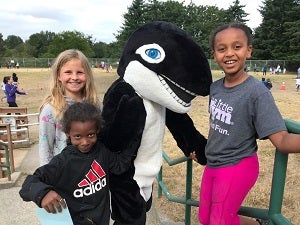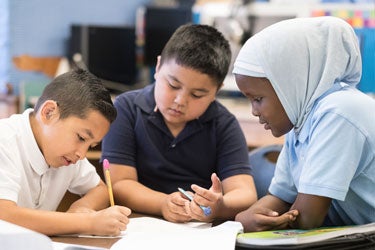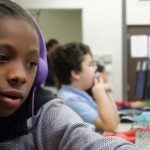5th Grade
A Family Guide to 5th Grade
In every grade, SPS’ core work is supporting student learning. We believe it is our responsibility to do whatever it takes to ensure that every child, regardless of race, gender, socioeconomic status, language proficiency, learning style or disability, achieves to their highest level.
Your child is entering 5th grade, the final year of elementary school. You may be starting to think about what’s next. How will you know that they are ready for middle school and adolescence?
Do they have the skills they need to read, write, speak, handle complex mathematics problems, ask questions, and apply evidence in science or social studies? Do you see interests in the arts or athletics starting to form?
This is a year for you to work closely with your child’s teachers to understand where they are on track or challenged.
Knowing the skills they need to learn and helping them develop strong habits for study, practice, social relationships and physical health will make a difference in their readiness to move to the next level of their education by the end of the school year.
Important Dates
September
- 1st day of school
November
- Parent-Teacher Conferences
December
- End of 1st Trimester; 1st Progress Report Available
March
- End of 2nd Trimester; 2nd Progress Report Available
June
- End of 3rd Trimester; 3rd Progress Report Available
Student Progress Reports
Report cards may not be new to you by now, but some of the standards and expectations on them this year will be important for you to learn. When you share information about your child with their teachers and school staff, you can learn about your child’s role in a community, how they interact in discussions and quiet times, with friends and with people different from them. Teachers gain ideas about how to help your child by hearing from you about their strengths and challenges.
Fifth grade, teachers and families should work together to meet social-emotional skills and learning readiness, as well as academic goals in language arts, math, science, social studies, physical education and arts sections on the progress report.
How to Access Progress Reports
Families will use The Source to view Student Progress Reports.
Parent and guardians can create an account with the email on record at their student’s school.
Student Success by Subject
Social Emotional Learning
At Seattle Public Schools we believe that social emotional learning prepares students for learning and life.

Social emotional learning (SEL) helps children:
• Manage emotions, show empathy
• Develop a healthy identity
• Make responsible decisions
• Have positive relationships
• Contribute to their community
These skills are important for learning and life.
At school, students learn and practice SEL skills throughout the day.
Reading and Writing
In English language arts (ELA), 5th grade students learn to:
- Take part in collaborative classroom conversations
- Independently read different types of writing
- Summarize their reading, with main ideas and details to support thinking
- Compare and contrast characters, settings, and events in a story
- Read and comprehend grade-level texts accurately and fluently, figuring out the meaning of unknown words
- Write about their opinions or information with facts and details
- Plan, revise, and edit to make writing more clear and organized
- Write for different people, purposes
Encourage your child to read 20 minutes or more every day.
Math

In 5th grade math, students will build on their 4th grade understanding of the four operations, unit fractions, decimal fractions, and measurement to:
- Understand the place value system in terms of powers of 10
- Read, write, and compare decimals to the thousandths place
- Perform operations with multi-digit whole numbers and with decimals to hundredths
- Add and subtract fractions with unlike denominators, including mixed numbers
- Multiply fractions Interpret products as scaling (i.e., resizing)
- Divide unit fractions (i.e., 1/3, 1/4, 1/8) by whole numbers and whole numbers by unit fractions
- Solve word problems involving fraction addition, subtraction, and multiplication
- Understand volume and its relationship
We believe all students have mathematical brilliance. Your child’s teacher seeks to cultivate brilliance to develop your child into a mathematical thinker and problem solver. Your child will see who sees the value of math in their life.
Science
What are 5th graders learning in science?
This is a time for transition in science education, with teaching and learning focused on three key areas in Washington state Science Learning Standards:
- Science/engineering practices used by professionals to explain the world or solve problems
- Core ideas that include fundamental scientific knowledge
- Crosscutting concepts frame scientific thinking across life, earth/space, physical sciences.
Your child’s report card shows performance expectations, for what students should be able to do by the end of a unit. The three dimensions are woven into each performance expectation.
Get outside together, taking time to notice, appreciate, and wonder about the natural world.
Social Studies
What’s important about 4th grade social studies?
The report card shows five areas of social studies that you and your child can discuss.
- Civics – Understanding organization and participation in United States government
- Economics – Understanding colonial laws, trade, and economic systems
- Geography – Constructing and using maps to learn about U.S. culture and migration
- History – Using multiple perspectives to learn about United States history
- Social Studies Skills – Using questions and multiple primary and secondary sources to get information and make conclusions
Physical Education
In physical education (PE), students build movement skills, knowledge, fitness, social well being, and confidence so they can enjoy a healthy, active lifestyle. Seattle Public Schools is committed to providing a quality physical education program to help students develop in these areas.
Our PE standards are based on motor and movement patterns and skills, as well as concepts like physical literacy, which is the ability, confidence, and desire to be physically active for life. PE is an instructional program, which makes it different from recess, free play, recreational sports, or athletics.
PE teachers work with general education teachers to provide high quality instruction for an average of 100 minutes per week, which is required by Washington state law. Schools organize PE times in different ways, but all students should be learning about their physical selves all year long!
Visual and Performing Arts
Research shows that students with an arts education are more engaged, do better in school, and are more likely to graduate and participate in community life. In Seattle Public Schools, we want every student to receive a comprehensive, predictable arts education during their K-12 years.
Each elementary school offers different arts programs, from possibilities including visual arts, general music, theatre, dance, or instrumental music.
Progress report standards come from the Washington state Arts Learning Standards, which focus on aspects of artistic process:
- Creating: developing new artistic ideas and work.
- Performing: interpreting and presenting artistic ideas / work
- Responding: understanding and evaluating meaning in the arts
- Connecting: Relating personally to artistic ideas and work
The arts are a core subject!
Make art together!

